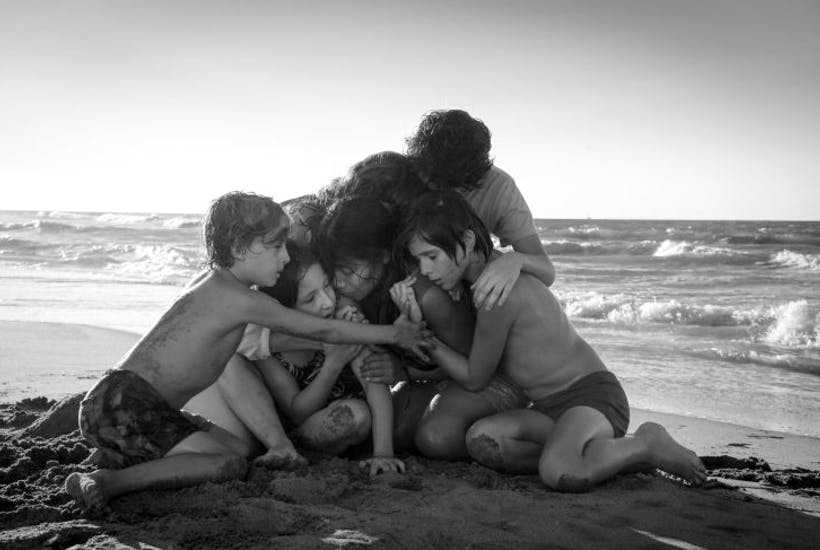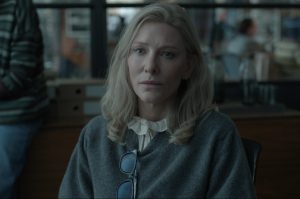My first viewing of Roma left me with a bitter taste: yes, the majority of critics are right in celebrating it as an instant classic, but I couldn’t get rid of the idea that this predominant perception is sustained by a terrifying, almost obscene, misreading, and that the movie is celebrated for all the wrong reasons.
Roma is read as a tribute to Cleo, a maid from the Colonia Roma neighborhood of Mexico City working in the middle-class household of Sofia, her husband Antonio, their four young children, Sofia’s mother Teresa, and another maid, Adela. It takes place in 1970, the time of large student protests and social unrest. As already in Y Tu Mama Tambien, Cuaron maintains distance between the two levels, the family troubles (Antonio leaving his family for a younger mistress, Cleo getting pregnant by a boyfriend who immediately abandons her), and this focus on intimate family topic makes the oppressive presence of social struggles all the more palpable as the diffuse but omnipresent background. As Fred Jameson would have put it, History as Real cannot be depicted directly but only as the elusive background that leaves its mark on depicted events.
So does Roma really just celebrate Cleo’s simple goodness and selfless dedication to the family? Can she really be reduced to the ultimate love object of a spoiled upper-middle class family, accepted (almost) as part of the family to be better exploited, physically and emotionally? The film’s texture is full of subtle signs which indicate that the image of Cleo’s goodness is itself a trap, the object of implicit critique which denounces her dedication as the result of her ideological blindness. I don’t have in mind here just the obvious dissonances in how the family members treat Cleo: immediately after professing their love for her and talking with her ‘like equals’, they abruptly ask her to do some house job or to serve them something. What struck me was, for example, the display of Sofia’s indifferent brutality in her drunken attempt to park the family Ford Galaxie in the narrow garage area: how she repeatedly scratches the wall with chunks of plaster falling down. Although this brutality can be justified by her subjective despair (being abandoned by her husband), the lesson is that, due to her dominant position, she can afford to act like that (the servants will repair the wall), while Cleo, who finds herself in a much more dire situation, simply cannot afford such ‘authentic’ outbursts – even when her whole world is falling apart, the work has to go on…
Cleo’s true predicament first emerges in all its brutality in the hospital, after she delivers a stillborn baby girl; multiple attempts to resuscitate the infant fail, and the doctors give the body to Cleo for a few moments before taking it away. Many critics who saw in this scene the most traumatic moment of the film, missed its ambiguity: as we learn later in the film (but can suspect now already), what truly traumatizes her is that she doesn’t want a child, so a dead body in her hands is good news.
At the film’s end, Sofia takes her family for a holiday to the beaches at Tuxpan, taking Cleo to help her cope with her loss (in reality, they want to use her there as a servant, although she just went through a painful stillbirth). Sofia tells the children over dinner that she and their father are separated and that the trip is so their father can collect his belongings from their home. At the beach, the two middle children are almost carried off by the strong current until Cleo wades into the ocean to save them from drowning even though she herself does not know how to swim. As Sofia and the children affirm their love for Cleo for such selfless devotion, she breaks down from intense guilt, revealing that she had not wanted her baby. They return to their house, with the bookshelves gone and various bedrooms reassigned. Cleo prepares a load of washing, telling Adela she has much to tell her, as a plane flies overhead.
After Cleo saves the two boys, they all (Sofia, Cleo and the boys) tightly embrace on the beach – a moment of false solidarity if there ever was one, a moment which simply confirms that Cleo is caught into the trap that enslaves her… Am I dreaming here? Is my reading not too crazy? I think Cuaron provides a subtle hint in this direction at the level of the form. The entire scene of Cleo saving the children is shot in one long take, with the camera moving transversally, always focused on Cleo. When one watches this scene, one cannot avoid the feeling of a strange dissonance between form and content: while the content is a pathetic gesture from Cleo who, soon after the traumatic stillbirth, risks her life for the children, the form totally ignores this dramatic context. There is no exchange of shots between Cleo entering the water and the children, no dramatic tension between the danger the children are in and her effort to save them, no point-of-view shot depicting what she sees. This strange inertia of the camera, its refusal to get involved in the drama, renders in a palpable way Cleo’s disentanglement from the pathetic role of a faithful servant ready to sacrifice herself.
There is a further hint of emancipation to come in the very final moments of the film when Cleo says to Adela: ‘I have much to tell you.’ Maybe, this means that Cleo is finally getting ready to step out of the trap of her ‘goodness’, becoming aware that her selfless dedication to her family is the very form of her servitude. In other words, Cleo’s total withdrawal from political concerns, her dedication to selfless service, is the very form of her ideological identity, it is how she ‘lives’ ideology. Maybe explaining her predicament to Adela is the beginning of Cleo’s ‘class consciousness’, the first step that will lead her to join the protesters on the street. A new figure of Cleo will arise in this way, a much more cold and ruthless – a figure of Cleo delivered from ideological chains.
But maybe it will not. It is very difficult to get rid of the chains in which we not only feel good but feel that we are doing something good. As T.S. Eliot put it in his Murder in the Cathedral, the greatest sin is to do the right thing for the wrong reason.
This article was originally published on The Spectator’s UK website.

















